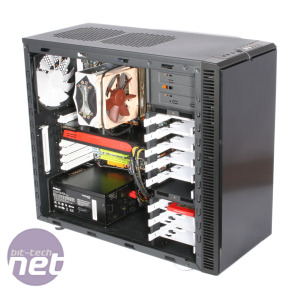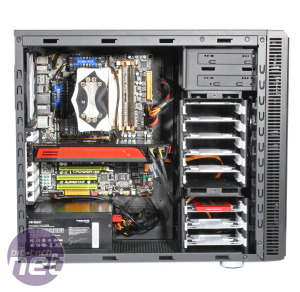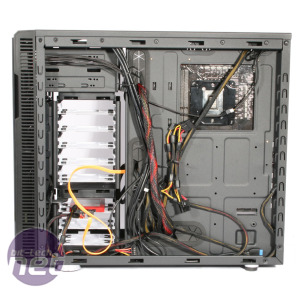
Performance Analysis
The Define R4, much like its predecessors, was simple and straight forward to build our test system into. Cable routeing are well spaced around the board to hide the 8-pin EPS12V cable, PCI-E power and 24-pin ATX cable and the front panel connectors are well placed to be easily tucked away out of sight. As we’ve already said, there isn’t a massive amount of room behind the motherboard but so long as you’re not bundling all your PSU’s cables into one thick coil, the side panel will fit back on with minimal trouble. A pack of cable ties are included to assist in this respect, with plenty of anchoring points provided.The Define series of cases have never delivered hardware-freezing cooling and the Define R4 is no different, instead prioritising noise reduction. However, a peak CPU delta T of 51°C is a good showing, matching the cooling of the R3 and Corsair’s competing 550D sans its blanking panels. GPU cooling is less impressive though, with the R4 producing a peak delta T of 49°C, placing it firmly towards the bottom of our cooling graphs. Dial the (already low-speed) fans down to 5V and cooling takes a big hit, with the CPU delta T rising 9°C to 60° and the GPU delta T rising to 50°C. However, we’d argue that the case’s bundled pair of 140mm fans are quiet enough as to not bother dropping them below 12V – save the fan controller for any extra fans you might wish to install.
We also took the opportunity to test the R4 with its ModuVent panels removed, as well as removing the main HDD cage. Both caused the GPU delta T to drop by 2°C, but the result is still 5°C warmer than the Define R3’s delta T of 42°C.


Click to enlarge - Removing the drive cage and blanking plates both improved cooling, but not by a huge amount. Those after low temperatures will want to add extra cooling fans.
Conclusion
Despite not setting our cooling graphs alight, the Define R4 delivers in every other way we’d expect from a modern ATX case. Discreet, well-built and loaded with useful features, it’s a sensible evolution of the design, offering increased flexibility alongside the sound-deadening features we’ve come to expect.What’s more Fractal has worked some kind of pricing voodoo and will be selling the Define R4 for just £80. That’s £35 cheaper than Corsair’s competing 550D and £10 cheaper than the R3 when it went on sale back in 2010. Considering the wealth of extras on offer, it makes for an enticing proposition.
We can’t ignore the limited out-of-the-box cooling though, especially as Intel’s Ivybridge CPUs can run very close to their peak delta Ts when overclocked. As such, if cooling is your primary concern then the Corsair Carbide 500R remains our chassis of choice. If you’re less inclined to push your hardware to its limit though, or just want a case with a little more refinement to it, the Define R4 is a great choice and a worthy successor to the Define legacy.

-
Value18 / 20
-
Design29 / 30
-
Features19 / 20
-
Cooling18 / 30


MSI MPG Velox 100R Chassis Review
October 14 2021 | 15:04










Want to comment? Please log in.